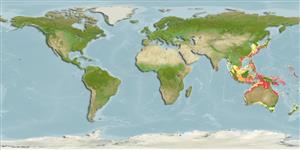Common names from other countries
Environment: milieu / climate zone / depth range / distribution range
Ecologia
marinhas demersal; intervalo de profundidade 13 - 78 m (Ref. 9494), usually 15 - 25 m (Ref. 9774). Tropical
Indo-West Pacific: Indo-Australian Archipelago.
Tamanho / Peso / Idade
Maturity: Lm ? range ? - ? cm
Max length : 25.0 cm SL macho/indeterminado; (Ref. 9774); common length : 17.5 cm SL macho/indeterminado; (Ref. 9774)
Espinhos dorsais (total) : 0; Raios dorsais moles (total) : 67 - 72; Espinhos anais: 0; Raios anais moles: 51 - 55. Body brownish, 2 double or tripe ocelli above and below lateral line and 1 on posterior third of straight section of lateral line. Many dark spots and rings scattered on body and median fins. Pectoral fin on ocular side with 12-13 rays. Pelvic fins short based, subequal and sub symmetrical in position, posterior 3-4 rays branched.
Inhabits muddy and sandy bottoms (Ref. 9774). Feeds on small benthic animals (Ref. 9774). Caught mainly with bottom prawn trawls (Ref. 9774).
Life cycle and mating behavior
Maturities | Reprodução | Spawnings | Egg(s) | Fecundities | Larvas
Distinct pairing (Ref. 205).
Kailola, P.J., 1991. The fishes of Papua New Guinea: a revised and annotated checklist. Vol. III. Gobiidae to Molidae. Research Bulletin No. 41, Research Section, Dept. of Fisheries and Marine Resources, Papua New Guinea. 153 p. (Ref. 6771)
Categoria na Lista Vermelha da IUCN (Ref. 130435)
CITES (Ref. 128078)
Not Evaluated
Ameaça para o homem
Harmless
Utilização humana
Ferramentas
Relatórios especiais
Descarregue XML
Fontes da internet
Estimates based on models
Preferred temperature (Ref.
115969): 24.5 - 29, mean 28 (based on 310 cells).
Phylogenetic diversity index (Ref.
82804): PD
50 = 0.5000 [Uniqueness, from 0.5 = low to 2.0 = high].
Bayesian length-weight: a=0.00741 (0.00343 - 0.01604), b=3.17 (3.00 - 3.34), in cm Total Length, based on LWR estimates for this Genus-body shape (Ref.
93245).
Nível Trófico (Ref.
69278): 3.5 ±0.37 se; based on food items.
Resiliência (Ref.
120179): Elevada, tempo mínimo de duplicação da população menor que 15 meses (Preliminary K or Fecundity.).
Fishing Vulnerability (Ref.
59153): Low vulnerability (21 of 100).
